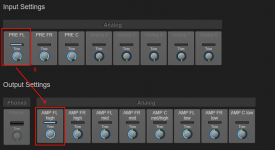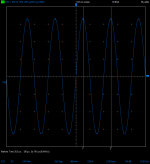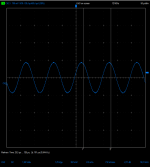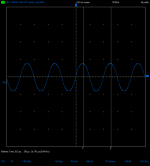Hi all,
I have a Motu 8A acting as an active crossover which is connected to a Crestron CNAMPX-16X60 amplifier. I'm trying to gain match the output of the Motu to the input of the amplifier.
The Motu, being pro gear, has a balanced out but can work as unbalanced with a floating R from a 1/4 TRS, which I'm using. Measuring the Motu with a scope I see an max output of ~4.5v peak-to-peak (non-clipping).
This is by far too much for the amplifier which needs a significantly smaller signal. So I can configure the Motu to significantly attenuate the signal but I'm assuming that's not doing wonders for the D->A conversion as it'll simply limit the effective bits used.
So I want to make a set of line-line attenuators with a best guess of the usual +4dBu -> -10dBV or about 11.79db attenuation which comes down to a K-factor of ~3.88.
From the specs I can see that the amplifier input impedance is 28kohm and the Motu has an output impedance of 100ohm.
Ideally I'd like to take these difference into account but I didn't find the math on how to do that exactly and which topology would be best suited for this. Any tips would be highly appreciated.
What I did find was some help on Uneeda Audio - Build your own attenuator pads where it's recommended for line-line to use a simple L topology making the input impedance leading.
The recommendation there, was to use the input impedance (28kohm) as the series and the shunt would then be ~7k2ohm.
I'm looking for some feedback on if that's the best way to do it, or if there are better ways to solve this.
Thanks!
I have a Motu 8A acting as an active crossover which is connected to a Crestron CNAMPX-16X60 amplifier. I'm trying to gain match the output of the Motu to the input of the amplifier.
The Motu, being pro gear, has a balanced out but can work as unbalanced with a floating R from a 1/4 TRS, which I'm using. Measuring the Motu with a scope I see an max output of ~4.5v peak-to-peak (non-clipping).
This is by far too much for the amplifier which needs a significantly smaller signal. So I can configure the Motu to significantly attenuate the signal but I'm assuming that's not doing wonders for the D->A conversion as it'll simply limit the effective bits used.
So I want to make a set of line-line attenuators with a best guess of the usual +4dBu -> -10dBV or about 11.79db attenuation which comes down to a K-factor of ~3.88.
From the specs I can see that the amplifier input impedance is 28kohm and the Motu has an output impedance of 100ohm.
Ideally I'd like to take these difference into account but I didn't find the math on how to do that exactly and which topology would be best suited for this. Any tips would be highly appreciated.
What I did find was some help on Uneeda Audio - Build your own attenuator pads where it's recommended for line-line to use a simple L topology making the input impedance leading.
The recommendation there, was to use the input impedance (28kohm) as the series and the shunt would then be ~7k2ohm.
I'm looking for some feedback on if that's the best way to do it, or if there are better ways to solve this.
Thanks!
....use the input impedance (28kohm) as the series....
That does not sound right.
And IMHO you can just twist and try.
I would try 2.7k and 1k L-pad, the amp across the 1k.
The recommendation there, was to use the input impedance (28kohm)
as the series and the shunt would then be ~7k2ohm.
What they meant to say was to use the amplifier Rin as the shunt impedance of the L pad,
and to add a large series resistor before the amplifier (roughly 100k).
But a lower impedance attenuator is better, with values in the 1k range.
A 28k series and a 15.8k shunt will get you in the ballpark. It will reduce your input impedance as seen by your source to about 10k but will probably be benign with your output source impedance at just 100R.


On 2nd thought, your source will actually see a higher input impedance of about 38k due to the combination of 28k and 10k...


What they meant to say was to use the amplifier Rin as the shunt....
Yeah, probably. But IAC that's a bad idea, in most cases. The Zin is almost never what it says it is, and often very un-flat.
OK, background theory. The source can (these days) surely drive 2k. If Rseries is 2k then source won't strain. Much. Then total shunt can be 666Ω. If amp is really 28k, then Rshunt is 650. Rshunt hardly matters until it gets down below 10k.
2K and 650Ω are (or used to be) odd values. I have drawers full of 1k and 2.7K, which comes to nearly the same thing. And makes worst-case source loading >3K, nicer.
Thanks for the explanations everyone! Going to go with 2k7 and 1k for the first try and see where we land.
Allright, after trying this it didn't work somehow. It made a sound like the signal was collapsing. So time to bring out more tools and toys and see what we can make of it.
I've just put all the connections on a breadboard connected straight through. This is 0dB from pre-amp into Motu which attenuates by 8dB at the input so that we have ~6db headroom on input if preamp is at 0db.

And that then is piped straight out to the amp (which is off). (This is measured at the amplifier side.)

This is a ~6.6vpp which is a tad high... So putting the motu to 12db output attenuation:

And now setting up the 2k7, 1k L pad:

This seems to be right on the money where I'd expect it. No idea why it works now but I guess this is pretty decent.
Eyeballing the signals I like the Motu attenuated one better. The L-pad variety has a flat top and bottom, though that might be my scope and/or the tiny difference in signal level.
I cannot hear the difference at any reasonable listening level. The Motu one sounds a bit brighter but if I do L/R compare one is at a slightly higher level and that makes a hard-to-overcome difference in what I hear.
I've just put all the connections on a breadboard connected straight through. This is 0dB from pre-amp into Motu which attenuates by 8dB at the input so that we have ~6db headroom on input if preamp is at 0db.

And that then is piped straight out to the amp (which is off). (This is measured at the amplifier side.)

This is a ~6.6vpp which is a tad high... So putting the motu to 12db output attenuation:

And now setting up the 2k7, 1k L pad:

This seems to be right on the money where I'd expect it. No idea why it works now but I guess this is pretty decent.
Eyeballing the signals I like the Motu attenuated one better. The L-pad variety has a flat top and bottom, though that might be my scope and/or the tiny difference in signal level.
I cannot hear the difference at any reasonable listening level. The Motu one sounds a bit brighter but if I do L/R compare one is at a slightly higher level and that makes a hard-to-overcome difference in what I hear.
Last edited:
- Home
- Source & Line
- Analog Line Level
- Line level attenuation check